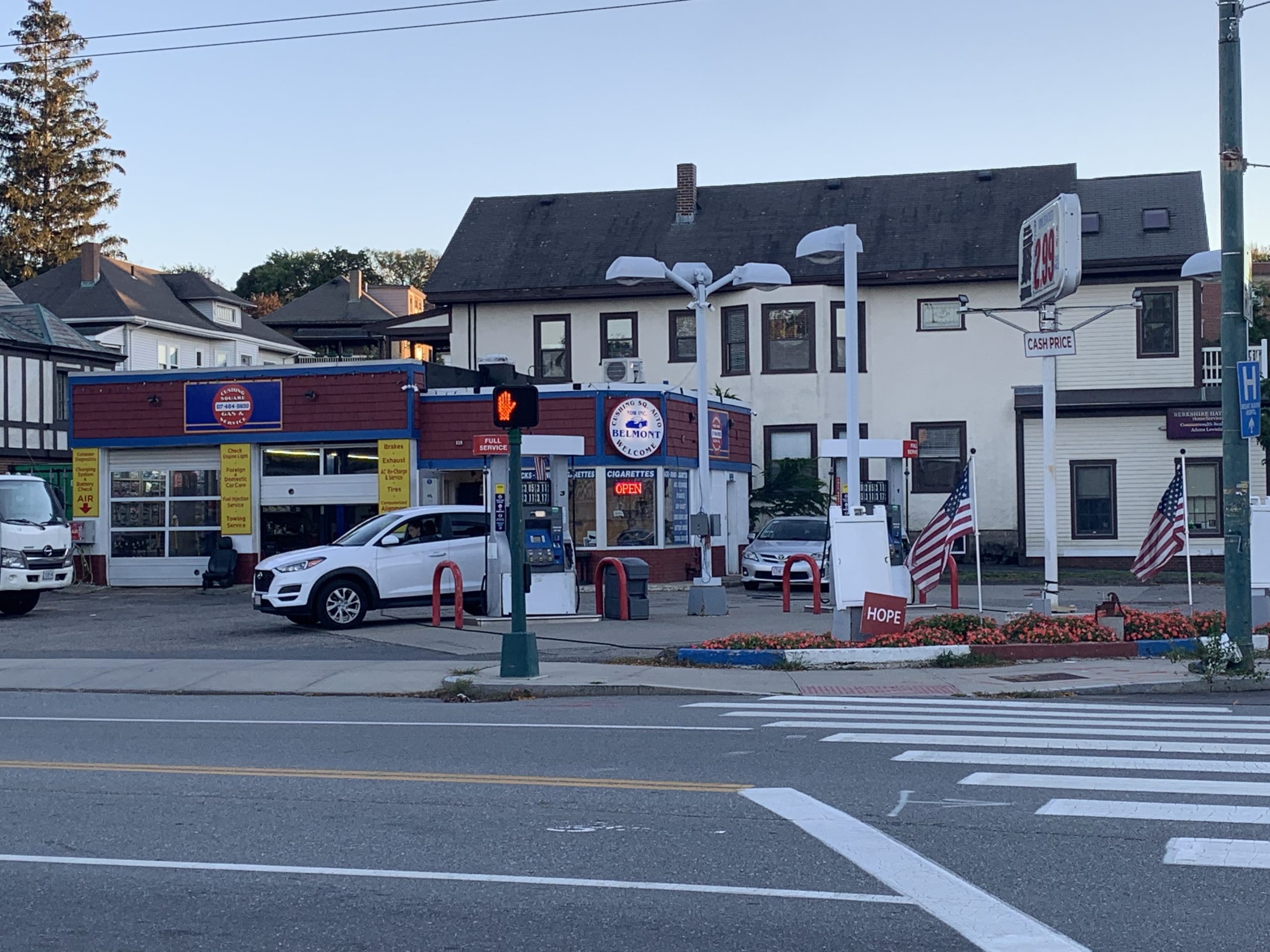Photo: Will this be the location of Belmont’s “fuel supply” for town vehicles?
An three month “experiment” using the local gas stations as the prime supply for the town’s nearly 180 vehicles could be voted on this week to determine the real world impact of removing the town’s municipal fuel tanks.
The Select Board is holding its second public forum on the possible replacement of the two 6,000 gallon underground fuel tanks at the DPW yard off C Street. On the agenda will be a discussion and possible vote on the trial program for off-site fueling of town-owned vehicles at the neighborhood service station including fire engines, police cars, highway department snow removal equipment and Belmont Light repair trucks.
A preview of the forum took place at the Select Board’s Monday Sept 19 meeting as Glenn Clancy, the director of the Department of Community Development, who is leading the Herculean effort to determine the future of the tanks and the size of the tanks that would supply the town vehicles. While the first forum on Aug. 3 focused on the topic of insuring above and underground tanks, residents opposed to the town’s “large” tanks at the June Town Meeting took to surveying gas stations as an alternative of the town’s fuel supply. It soon became an issue those residents took to heart as one reason to remove the tanks.
In response to several board members to wanted an analysis conducted, Clancy presented to the board a highly-detailed draft report (the main report is 13 table-laden pages with a large number of supporting data) on the fuel consumption for all the town’s 179 vehicles in fiscal year 2020 from July 1 2019 to June 30, 2020. The culmination of three months of work, Clancy studied the when and how much each vehicle consumed either diesel or unleaded gas .
“The report is supported by a lot of data, there’s a lot of information in there in terms of consumption when and where,” Clancy told the board of the draft that took three months to prepare.
“The report will be the centerpiece of the next fuel forum,” Clancy said, culminating with the board possible approving one of two recommendations: the first is allow diesel fuel to remain at the DPW yard.
This is going to show whether you save money or lose money, but it’s not going to show if we have a Blizzard of ‘78 whether or not we’re going to be completely screwed because we’re going to private stations that [will be] closed for two weeks
Adam Dash, Chair Belmont Select Board
The second is what Clancy dubbed the “experiment” in which the town vehicles will fuel up at the town’s nine private service stations from 6 a.m. to 10 p.m. The trail will take place over three months beginning Oct. 15 with the hope it will “capture at least one snow event.”
The trial will produce “real world experience” using a gas station vs. the pumps at the Town Yard.
Clancy said the department heads who rely on the fleet have been informed of the possible trial.
“My hope is that at the end of the [Sept. 28] forum, the public and the board both agree that it makes sense for us to move forward with that [experiment],” said Clancy.
On area the report has analyzed is the cost difference using private gas stations and the town’s current practice of being a member of a fuel consortium with a dozen eastern Massachusetts communities that purchases fuel at a group discount. Clancy’s data indicates the town saving up to $14,700 if it remains in the partnership.
Board Vice Chair Roy Epstein said the draft “is really an enormous amount of work and I think it provides the basis for a much more informed discussion of this issue,” adding the report’s detail analysis provides “the rational for keeping diesel at the DPW yard.”
Yet Epstein noted making conclusions with data over several years can be troublesome as underlying economic factors – recessions, Covid downturn, unsustainable recoveries – must be factored into the analysis as well as calculating productivity effects when fueling at the private service station vs. at the DPW yard and the special case of police vehicles fueling at the DPW yard rather than at a service station because they operate a third shift.
“Predictions are not guarantees but in terms of making predications, that [the data] is reliable,” said Epstein.
Clancy noted part of the goal of the three month trail is to look at those types of operational issues “and see whether or not they work.”
Adam Dash, the board’s chair who said he would want to hear public comment before a vote after the forum either on the 28th or Oct. 4 when the board is scheduled to meet, said his major concern is fuel security.
“This is going to show whether you save money or lose money, but it’s not going to show if we have a blizzard of ‘78 whether or not we’re going to be completely screwed because we’re going to private stations that [will be] closed for two weeks,” said Dash.








Your own supply of fuel is a better option due to the fact. They are all emergency vehicles that cant be subject to outside factors